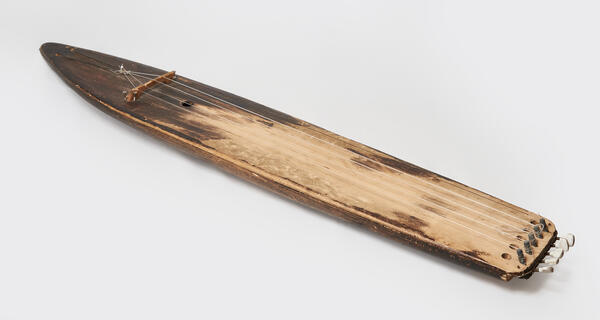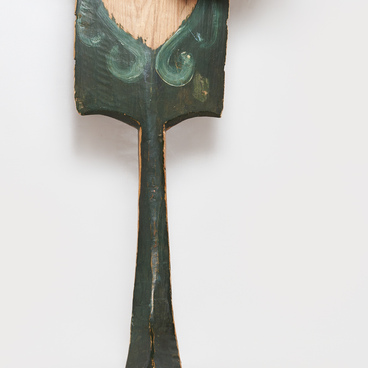Nars-yukh (narsyukh, literally — “playing tree”) is a stringed plucked instrument, a staple in the Khanty culture. It resembles a boat and has long been used for both ritual and everyday playing.
As a rule, a nars-yukh was made from spruce or aspen, the top plank was attached to the body with fish glue. Strings made of deer tendons were also coated with this glue. One end of the instrument was made pointed, the other, on the contrary, was bifurcated and connected with a crossbar. A soundboard was placed on a cross-shaped sound hole, and three, five or seven strings were put on over it, securing them between the crossbar and the pointed end (at this point they were tied with a cord). Tuning pegs made of bird bones or wooden pins were used to tighten the strings.
Traditionally, only men played the nars-yukh, but nowadays women learn this skill as well. The performer held the instrument on his knees, pressing it to his stomach, in a horizontal, slightly inclined position, plucked the strings with one hand, and pressed them at different points with the other, toning the sound. In some cases, they played with both hands or used a small plank — a plectrum (a flat tool used for plucking a stringed instrument). Reonalda Stepanovna Olzina notes, “Salt, shot, pebbles, glass or metal plates were placed inside some instruments to enhance the sound.”
Shamans used these instruments when communicating with spirits — kamlanie — and never sold their instrument: it was believed that a person would sell his soul along with it. A nars-yukh also acted as an assistant for musicians-healers. Outside of performing any ritual functions, songs and legends about the exploits of heroes and bogatyrs were played on this instrument. Traditional “bear games” always included musicians playing the nars-yukh.
Modern nars-yukh models are somewhat different from traditional ones. Instead of a cross-shaped sound hole, they feature a round one, the body is not bifurcated, and ordinary metal strings are used. This version of the nars-yukh is mainly used by musicians of ethnic music groups.
The presented instrument was kept by the parents of a resident of the village of Sherkaly Nadezhda Georgievna Fedotova (born in 1958).



